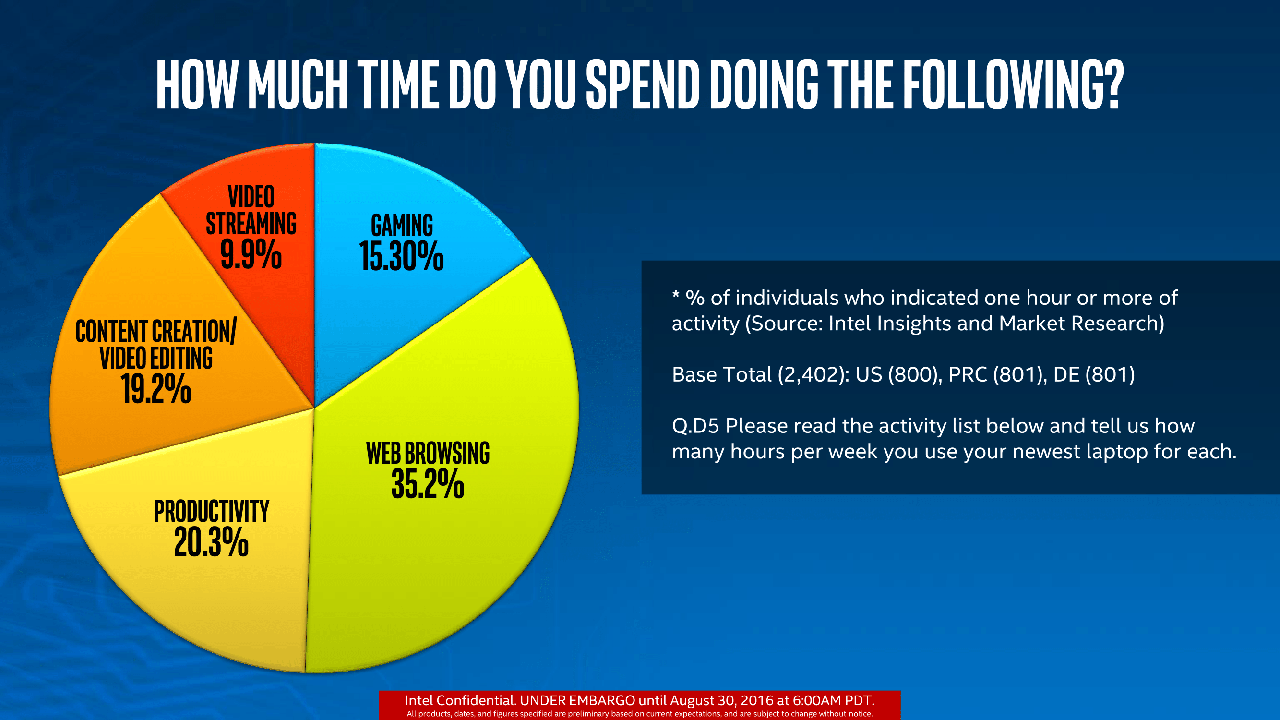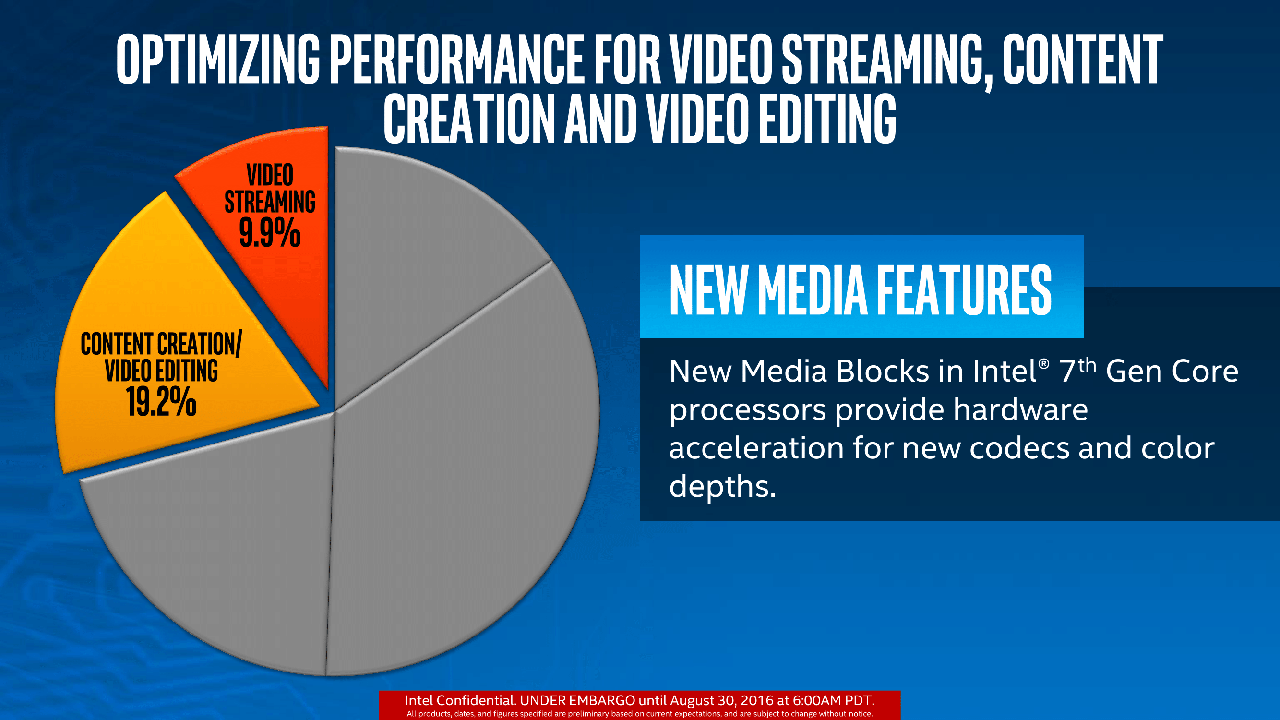Intel Kaby Lake: 14nm+, Higher Clocks, New Media Engine
The Media Engine
The 4K Explosion
Intel cited a range of data to quantify the importance of its media optimizations. The company also commissioned a survey of 2400 users to back up its claims that media optimizations will provide the broadest swath of performance enhancements for average users.
Intel indicated that more than 50 products with native 4K panels will come to notebooks during the Kaby Lake generation. Other new types of content streaming, such as 360-degree videos and multi-streaming, are also becoming prevalent. The move to 4K is picking up steam; analysts predict that over 100 million 4K UHD devices will be in the PC market by 2020.






The existing VP8 and AVC codecs are not as efficient with high-definition video, so new codecs that reduce the amount of bandwidth required to stream bulky HD and 4K video (by doubling compression) are becoming more popular. The powerful new codecs require more computational grunt power to view. VP9, which streams video without buffering, is becoming one of the most prevalent codecs. YouTube has streamed over 25 billion hours of HD video (720p and up) with VP9. HEVC is also gaining ground, and the addition of hardware-accelerated HEVC and VP9 encoding/decoding is a key piece of Intel's mobility strategy.
Intel claims the addition of HEVC 10-bit hardware acceleration increases battery life during 4K streaming by 75% (up to 9.5 hours). It also indicates that users can view 360-degree 4K video for up to seven hours on a single battery charge.
Gen9 Media Architecture
Intel improved its media engine to increase performance during video streaming and other demanding multitasking workloads, which it painfully describes as "mega-tasking." Intel characterizes a typical mega-tasking workload as playing a game while streaming to Twitch, which requires capturing gameplay while simultaneously encoding and decoding.




The key to boosting performance during heavy workloads requires decoupling some of the processes, such as encoding and decoding, from the main render pipeline. The company employs the same basic Gen9 graphics core architecture that it used with the Skylake platform, albeit with a few enhancements. The three subslices in the middle house the EUs, cache, 3D sampler, and media samplers, and they share the resources to the left (un-slice) while handling the bulk of the rendering work.
Intel focused on targeted optimizations to the MFX (decode/encode) and VQE engines, which it outlines in green. These units sit outside of the rendering pipeline and operate independently of the subslices, increasing parallelism. During a gaming session, for instance, the subslices handle the rendering work while the MFX engine tackles the encoding/decoding tasks. Each collection of three subslices functions as its own larger slice and Intel can vary the number of slices to adjust performance in various SKUs.
Get Tom's Hardware's best news and in-depth reviews, straight to your inbox.
The Multi-format Codec (MFX) serves multiple functions, such as support for legacy VP8 and AVC codecs. Intel also adds full hardware support for HEVC 10-bit decode/encode, VP9 8/10-bit decode, and VP9 8-bit encode. Skylake employed a hybrid implementation that used both the CPU and GPU to process some codecs, but Kaby Lake's fully hardware-accelerated processing reduces CPU utilization, and thus power consumption, during video playback.
Intel also added HDR (High Dynamic Range) support to its VQE engine, which supports video processing and content enhancement features like color correction, color enhancement, skin tone enhancement, and noise reduction.
The net performance value is impressive: what we're calling the Gen9+ graphics engine (improved from Skylake's Gen9 nomenclature) supports up to eight simultaneous 4Kp30 AVC and HEVC streams; and it handles more demanding real-time 4Kp60 HEVC decode operations at 120 Mb/s.
MORE: Best CPUs
MORE: Intel & AMD Processor Hierarchy
MORE: All CPU Content
Current page: The Media Engine
Prev Page 14nm+ Overview, Tri-Gate And Speed Shift Next Page Media Performance
Paul Alcorn is the Editor-in-Chief for Tom's Hardware US. He also writes news and reviews on CPUs, storage, and enterprise hardware.
-
ComputerSecurityGuy Yup, Skylake Refresh. Higher clocks. Slightly lower power consumption. Probably saw a demo of Overwatch on Iris Pro 680 (580 with 200mHz or so higher clocks. Overall, probably not a very interesting release. The only hopeful thing is they might bring Iris/Iris Pro to lower end or lower power SKUs.Reply -
80-watt Hamster Sheesh, why all the negativity? As someone who put together a Skylake platform with an i3, I'm looking forward to more capable -K processors being released for the same socket.Reply -
txhorn Kaby Lake's hardware encode and decode of 4k codecs is significantly better than Skylake. VP9 4k decode is down to 10-20% cpu usage from 70-80% usage. That's pretty awesome for HTPC's and high-res portable battery life.Reply -
AndrewJacksonZA Typo on page two: "Intel is optimizing its transistors by improving their fin profile with taller fins and a wider gate pitch" That should be a NARROWER gate pitch.Reply -
goblinissimus Nothing about USB 3.1 Gen 2, TB3, DP1.3, HDMI 2.0b/HDCP 2.2?Reply
Also, 12 bit (aka Dolby Vision or DV) HEVC decode would have been nice. -
digitalgriffin You know intel keeps bragging about how you get more battery life. Yet manufacturers keep shrinking the Wh on the batteries and intel keeps raising their prices. You really gain nothing in terms of battery life or cost.Reply -
80-watt Hamster Reply18520394 said:$389 for a 2 core 4 thread processor....thanks but no thanks.
4C8T perhaps you mean? I can't see Intel trying to charge nearly $400 for an i3.